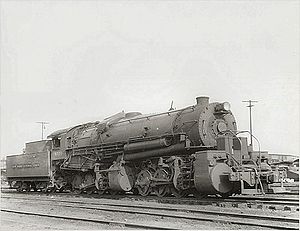
0-8-8-0
Encyclopedia


Whyte notation
The Whyte notation for classifying steam locomotives by wheel arrangement was devised by Frederick Methvan Whyte and came into use in the early twentieth century encouraged by an editorial in American Engineer and Railroad Journal...
for classifying the wheel arrangement
Wheel arrangement
In rail transport, a wheel arrangement is a system of classifying the way in which wheels are distributed beneath a locomotive.. Several notations exist to describe the wheel assemblies of a locomotive by type, position, and connections, with the adopted notations varying by country...
of steam locomotive
Steam locomotive
A steam locomotive is a railway locomotive that produces its power through a steam engine. These locomotives are fueled by burning some combustible material, usually coal, wood or oil, to produce steam in a boiler, which drives the steam engine...
s, an 0-8-8-0 is a locomotive with two sets of eight driving wheel
Driving wheel
On a steam locomotive, a driving wheel is a powered wheel which is driven by the locomotive's pistons...
s and neither leading wheel
Leading wheel
The leading wheel or leading axle of a steam locomotive is an unpowered wheel or axle located in front of the driving wheels. The axle or axles of the leading wheels are normally located in a truck...
s nor trailing wheel
Trailing wheel
On a steam locomotive, a trailing wheel or trailing axle is generally an unpowered wheel or axle located behind the driving wheels. The axle of the trailing wheels was usually located on a trailing truck...
s. Two sets of driving wheels would give far too long a wheelbase to be mounted in a fixed locomotive frame, so all 0-8-8-0s have been articulated locomotive
Articulated locomotive
Articulated locomotive usually means a steam locomotive with one or more engine units which can move independent of the main frame. This is done to allow a longer locomotive to negotiate tighter curves...
s of the Mallet
Mallet locomotive
The Mallet Locomotive is a type of articulated locomotive, invented by a Swiss engineer named Anatole Mallet ....
type, whether simple or compound
Compound locomotive
A compound engine unit is a type of steam engine where steam is expanded in two or more stages.A typical arrangement for a compound engine is that the steam is first expanded in a high-pressure cylinder, then having given up heat and losing pressure, it exhausts directly into one or more larger...
. In the UIC classification
UIC classification
The UIC classification of locomotive axle arrangements describes the wheel arrangement of locomotives, multiple units and trams. It is set out in the International Union of Railways "Leaflet 650 - Standard designation of axle arrangement on locomotives and multiple-unit sets". It is used in much...
, this arrangement would be, refined to Mallet locomotives, (D)D. The type was sometimes called Angus in North America.
Other equivalent classifications are:
UIC classification
UIC classification
The UIC classification of locomotive axle arrangements describes the wheel arrangement of locomotives, multiple units and trams. It is set out in the International Union of Railways "Leaflet 650 - Standard designation of axle arrangement on locomotives and multiple-unit sets". It is used in much...
: DD (also known as German classification and Italian classification)
French classification: 040+040
Turkish classification
Turkish classification
In the Turkish classification system for railway locomotives, the number of powered axles are followed by the total number of axles. It is identical to the Swiss system except that the latter places a slash between the two numbers.Thus0-6-0 becomes 33...
: 44+44
Swiss classification: 4/4+4/4
The lack of leading and trailing wheels to assist the tracking and stability of the locomotive means that the 0-8-8-0 type is not suited to high speeds. The vast majority have seen use as very heavy switcher
Switcher
A switcher or shunter is a small railroad locomotive intended not for moving trains over long distances but rather for assembling trains ready for a road locomotive to take over, disassembling a train that has been...
s (generally for hump yard work), transfer locomotives for hauling cuts of cars between rail yards, or pushers for assistance on grades.
Most locomotives of this arrangement were built and served in North America, but there were exceptions. The Bavaria
Bavaria
Bavaria, formally the Free State of Bavaria is a state of Germany, located in the southeast of Germany. With an area of , it is the largest state by area, forming almost 20% of the total land area of Germany...
n State Railways (K.Bay.St.B) built some 0-8-8-0T tank locomotive
Tank locomotive
A tank locomotive or tank engine is a steam locomotive that carries its water in one or more on-board water tanks, instead of pulling it behind it in a tender. It will most likely also have some kind of bunker to hold the fuel. There are several different types of tank locomotive dependent upon...
s of class Gt 2x4/4, classified after unification of Germany's railway systems as class BR96. These worked trains over heavily graded stretches of line, and were the largest locomotives in Europe when introduced.

